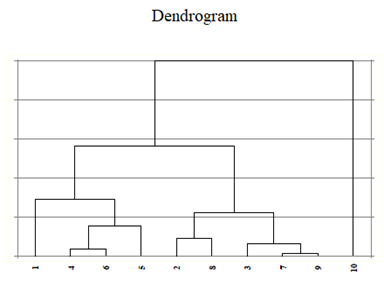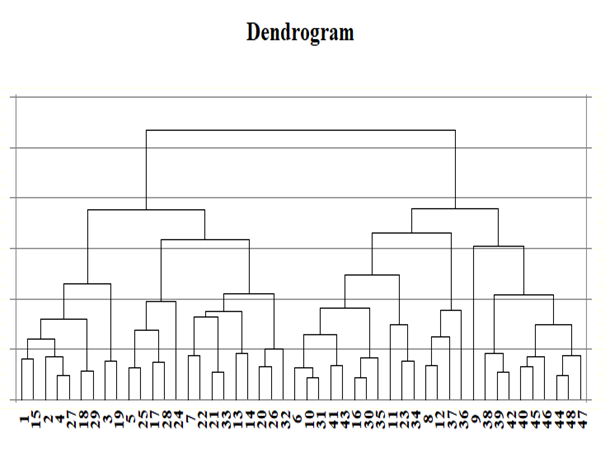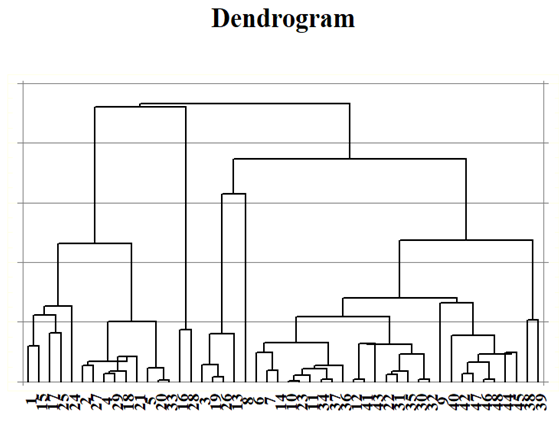-
Paper Information
- Paper Submission
-
Journal Information
- About This Journal
- Editorial Board
- Current Issue
- Archive
- Author Guidelines
- Contact Us
International Journal of Genetic Engineering
p-ISSN: 2167-7239 e-ISSN: 2167-7220
2023; 11(2): 15-18
doi:10.5923/j.ijge.20231102.01
Received: Apr. 27, 2023; Accepted: May 16, 2023; Published: May 22, 2023

Cluster Analysis of Valuable Economic Features of Introgressive Forms
Gafurjon Gulomov1, Bekhzod Sirojidinov2
1Southern Paxtakor 3/17, 170100, Andijan, Uzbekistan
2Yunusobod District 19/475, 100001, Tashkent, Uzbekistan
Correspondence to: Gafurjon Gulomov, Southern Paxtakor 3/17, 170100, Andijan, Uzbekistan.
| Email: |  |
Copyright © 2023 The Author(s). Published by Scientific & Academic Publishing.
This work is licensed under the Creative Commons Attribution International License (CC BY).
http://creativecommons.org/licenses/by/4.0/

In this article, a comprehensive analysis of introgressive hybrid forms of cotton is more important than a separate analysis of quantitative traits for creating lines and varieties with a complex of valuable economic traits, and many scientific studies have been carried out on the application. Information on the methods of factorial and cluster analysis of local varieties and lines. It has been established that the level of dominance of the cotton weight in terms of the weight of one box, the length of the fibre, the yield of the fibre, and the weight of 1000 seeds is inherited in positive and negative intermediate, dominant and extremely dominant states. In order to maintain the state of positive heterosis achieved in these ranges, it is necessary to continue the work of genetic breeding research in the next generations. During the studies, cluster analysis of valuable farm marks of 10 parent forms, F1 and F2 of hybrid plants (cotton weight in one boll, 1000 pieces of seed weight, fiber output and fiber length), which were initially studied for cluster analysis, quantitative marks were used. The indicators of valuable economic marks of these ridges were determined and statistically analyzed in laboratory and field conditions.
Keywords: Variety, Line, Hybridization, Cluster, Generation, Heterosis
Cite this paper: Gafurjon Gulomov, Bekhzod Sirojidinov, Cluster Analysis of Valuable Economic Features of Introgressive Forms, International Journal of Genetic Engineering, Vol. 11 No. 2, 2023, pp. 15-18. doi: 10.5923/j.ijge.20231102.01.
Article Outline
1. Introduction
- Complex analysis of introgressive hybrid forms of cotton is more important than individual analysis of quantitative traits for creating lines and varieties with a set of valuable economic traits. A lot of scientific studies have been conducted on the application of factor and cluster analysis methods in local varieties and ranges. The creation of new varieties has always been of the highest importance [1-5].If more than two populations are taken to determine plant traits, then it is necessary to divide the genotypes into groups according to their closeness to each other. For this purpose, to determine the level of diversity of these varieties according to their quantitative characteristics and to combine them according to their mutual proximity, the cluster analysis method was used to achieve this goal.Cluster analysis is a multivariate statistical analysis method that identifies the properties of objects that are similar to each other and divides them into the same groups based on these properties.In our experiment, the clustering of the lineages was determined using the Statgraphics computer program using Euclidean distance as a measure of genetic closeness, and Ward's method as a clustering method.
2. Literature Review
- Kh. Muminov, Z. Ernazarova, B. Amanov, the primary resources and interspecific amphidiploid F1-F6 generation plants belonging to different clusters showed a wide variation in characters, according to the weight of cotton in one boll, 2.3 -6.2125 g., 67.3-125.529 g. by the weight of 1000 seeds, 24.9-34.4125 mm by fibre length, 31.4-40.2625% by fibre yield, 6.3-7.5875 g according to the fibre index. established Also F6 G. hirsutum subsp. euhirsutum "Kelajak" variety F1 (G.arboreum subsp. perenne x G.arboreum subsp. obtusifolium var. indicum) combination families, 6.6 ± 0.13 g of cotton in one boll. ("Oila-41"), 125.8 ± 3.48 g by weight of 1000 seeds. ("Oila-59"), fibre length 34.5 ± 0.16 mm ("Oila-8"), fibre yield 40.3 ± 0.65% ("Oila-59"), 8.5 ± 0.23 g according to the fibre index. High-performance plants up to ("Oila-59") were isolated. Within the fourth cluster (F5G. hirsutum L. x (G.arboreum L. x G.arboreum L.) «Oila-5», «Oila-13», «Oila-8», «Oila-59», «Oila-14", F6 G.hirsutum L. x (G.arboreum L. x G.arboreum L.) "Oila-13", "Oila-5", " Oila -59") is a family with valuable economic traits recommended the use of plants as practical and theoretically valuable donors in genetics and selection research. Samanov Sh.A., et al. in their scientific research, divided the cluster analysis of the valuable economic characters of the introgressive lines of cotton into different groups. According to the characteristics of the cotton weight in one boll, fibre length, fibre yield, and 1000 seed weight, the degree of dominance was determined to be inherited in a positive and negative intermediate, dominant and extremely dominant state. He emphasized that to maintain the state of positive heterosis achieved in these ranges, it is necessary to continue carrying out genetic-selection studies in the next generations [6-12].
3. Material and Methods
- Scientific research work was carried out within the scientific research topic of Andijan State University "Genetics and selection of cotton and soybean plants grown in farms of Fergana Valley" (2018-2022). Cotton G. hirsutum ssp. euhirsutum (genome AD1) "Bukhoro-6", "Omad", "Genofond-2" varieties, G. mustelinum Miers ex Watt, [F5 Kalajak x (ssp. nanking (white fibre) x G. nelsonii)], [F5 Namangan 77 x (ssp. obtusifolium var. indicum x G.australe)], {F4B1С Namangan 77 x [Namangan 77 x (ssp. obtusifolium var. indicum x G.australe)]}, {F4B1С [Namangan 77 x (ssp. obtusifolium var. indicum x G.australe)] x Namangan 77}, {F4B1С Kelajak x [Kelajak x (ssp. nanking (white fibre) x G.nelsonii)]}, {F4B1С [Kelajak x (ssp. nanking (white fibre) x G.nelsonii)] x Kelajak} introgressive hybrid forms were used.Cluster analysis is a multivariate statistical analysis method that identifies the properties of objects that are similar to each other and divides them into the same groups based on these properties.In our experiment, the clustering of the lineages was determined using the Statgraphics computer program using Euclidean distance as a measure of genetic closeness, and Ward's method as a clustering method.
4. Results Discussion
- If more than two populations are taken to determine plant traits, then it is necessary to group the genotypes according to their closeness to each other. For this purpose, the cluster analysis method was used to determine the degree of diversity in terms of quantitative characteristics of these varieties and to combine them according to their mutual proximity.Quantitative traits of the 10 hybrid forms studied and the parental forms were used as a template for cluster analysis. Quantitative characteristics of these hybrid shawls were studied, cotton weight in one bag, weight of 1000 seeds, fibre length, and fibre yield indicators were determined in laboratory and field conditions and statistically analyzed.According to the results of research, a high indicator on the cotton weight mark in one boll, which is one of the valuable economic signs s [F5 Kelajak x (ssp. nanking (white fiber) x G.nelsonii)] in the form of a hybrid (6.0 grams), which is relatively low by this mark G.mustelinum (2.0 grams) was observed in hybrid combinations.A high indicator on the mark of the weight of 1000 pieces of seeds is G.hirsutum ssp. if euhirsutum" Omad " is in hybrids (115.1 grams), then the low result on this mark is G.mustelinum (95.0 grams) was manifested in hybrid combinations.The average figure in parental hybrid forms on the mark of fiber length from valuable farm mark is 34.4 mm. ni, while the fiber output mark was 37.75%.The results from analysis of the conducted experiments show that cotton is divided into 3 main groups within the cluster when we analyze the economic characteristics of cotton, i.e. cotton weight per boll, 1000 seed weight, fiber yield and fiber length characteristics, and economic economic characteristics. it became known.The first main large group consists of parent forms [F5 Kelajak x (ssp. nanking (white fiber) x G.nelsonii)], {F4B1С [Namangan 77 x (ssp. obtusifolium var. indicum x G.australe)] x Namangan 77}, {F4B1С [Kelajak x (ssp. nanking (white fiber) x G.nelsonii)] x Kelajak}, {F4B1С Kelajak x [Kelajak x (ssp. nanking (white fiber) x G.nelsonii)]} and it was found that valuable economic markers are close to each other.The second main large group [F5 Namangan 77 x (ssp. obtusifolium var. indicum x G.australe)], G. hirsutum ssp. euhirsutum «Omad», {F4B1С Namangan 77 x [Namangan 77 x (ssp. obtusifolium var. indicum x G.australe)]}, G.hirsutum ssp. euhirsutum "Bukhara-6", G. hirsutum ssp. euhirsutum "Genofond-2" combinations are known to have entered, and entered this second cluster group [F5 Namangan 77 x (ssp. obtusifolium var. indicum x G.australe)], G. hirsutum ssp. euhirsutum "Omad" that the quantitative characteristics of combinations are moderately close, {F4B1С Namangan 77 x [Namangan 77 x (ssp. obtusifolium var. indicum x G.australe)]}, G. hirsutum ssp. euhirsutum "Bukhara-6", G. hirsutum ssp. euhirsutum "Genofond-2", and the valuable economic traits of the combinations were shown to be very close to each other, G. hirsutum ssp. euhirsutum "Bukhara-6", G. hirsutum ssp. euhirsutum "Genofond-2" showed that the economic characteristics of the combinations are very close.Valuable economic characters of parental forms, when cluster analysis was performed in Statgraphics computer program, only 1 combination, i.e., G. mustelinum, was found to have lower valuable economic characters than any of the above 9 combinations, and it was separated into a separate cluster group.
 | Figure 1. Cluster analysis of economic traits of parental forms (cotton weight per boll, 1000 seed weight, fibre yield and fibre length) |
 | Figure 2. Cluster analysis of valuable economic traits of F1 hybrid plants (cotton weight per boll, 1000 seed weight, fibre yield and fibre length) |
 | Figure 3. Cluster analysis of valuable economic traits of F2 hybrid plants (cotton weight per boll, 1000 seed weight, fibre yield and fibre length) |
5. Conclusions
- The results of the cluster analysis of our research show that the parent, F1 and F2 hybrid forms are cluster analyzed and differ from each other in size and shape, but they are distant and partially close to each other in terms of valuable traits. was determined. Quantitative indicators of introgressive hybrid forms according to the result of cluster analysis showed that hybrid forms belonging to the same species are close to each other. In our research, the cluster analysis of hybrid forms of F2 showed that F5 Kalajak x (ssp. Nanking (white fibre) x G.nelsonii)] x Bukhara-6 had high economic traits. It was found that this line can be used in the process of practical selection as one of the productive varieties with high performance in terms of all economic indicators. Complex analysis of introgressive hybrid forms of cotton is more important than individual analysis of quantitative traits for creating lines and varieties with a set of valuable economic traits. In the selection of initial sources for the practical selection process or in the evaluation of lines, individual selection for each character is often not a correct conclusion, and cluster analysis is the relationship of these characters to each other and several gives an opportunity to choose varieties or samples consisting of biotypes that are close to each other in terms of characteristics. In addition, when choosing a form for the initial source, it shows that not one type, but one cluster, can be used to transfer a certain character.
 Abstract
Abstract Reference
Reference Full-Text PDF
Full-Text PDF Full-text HTML
Full-text HTML